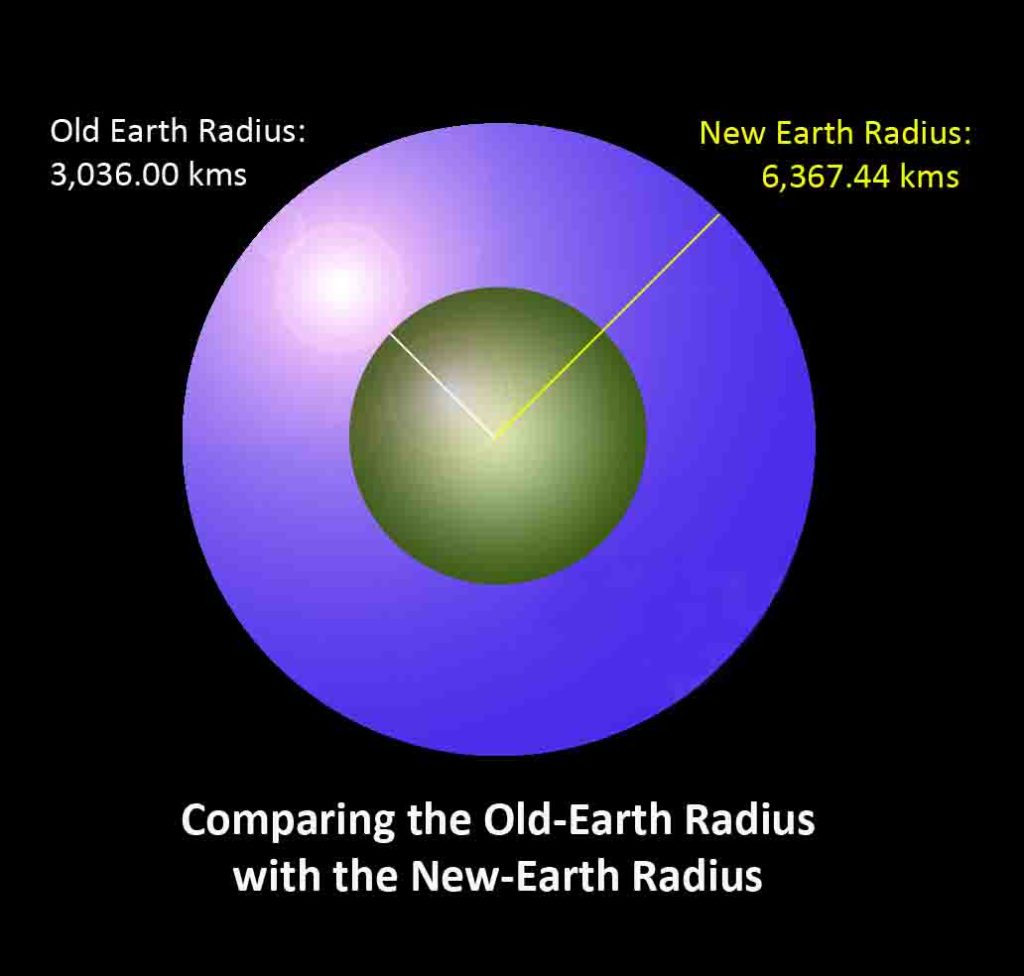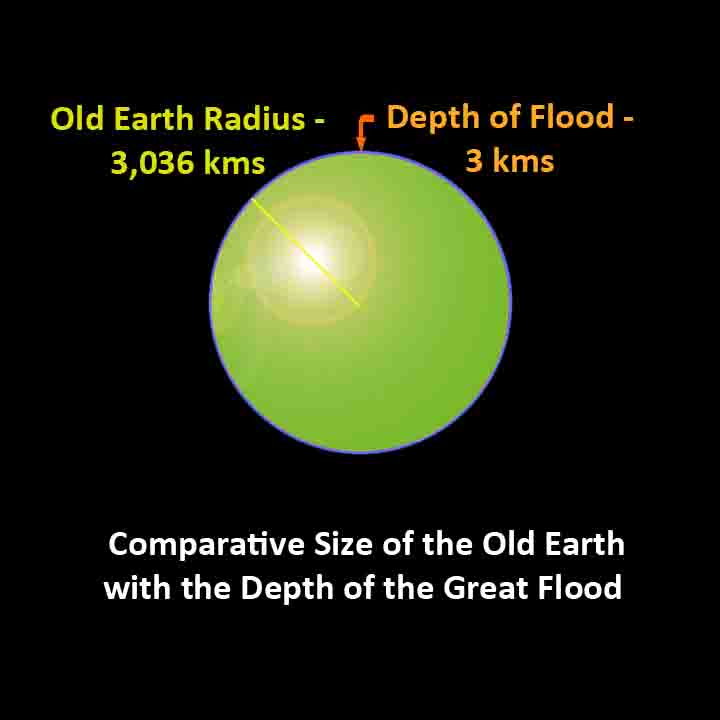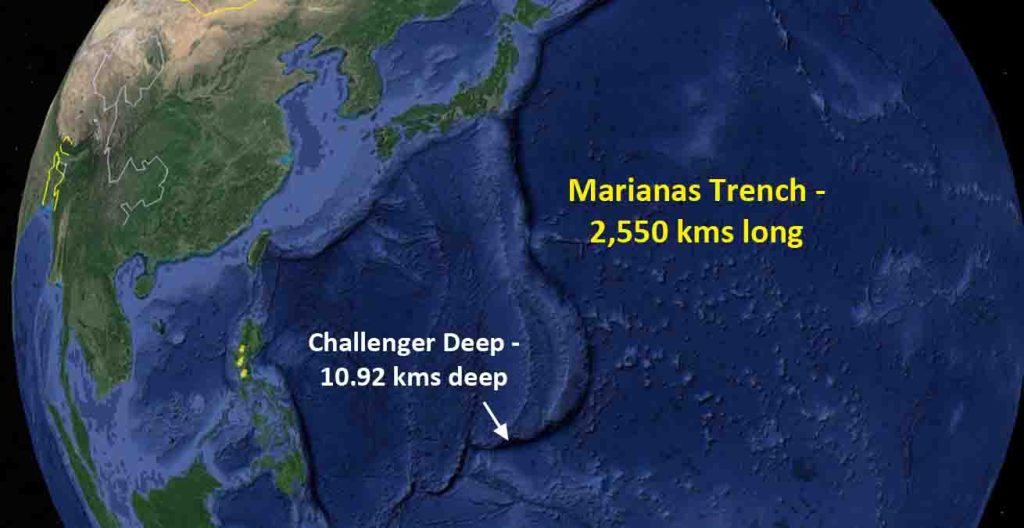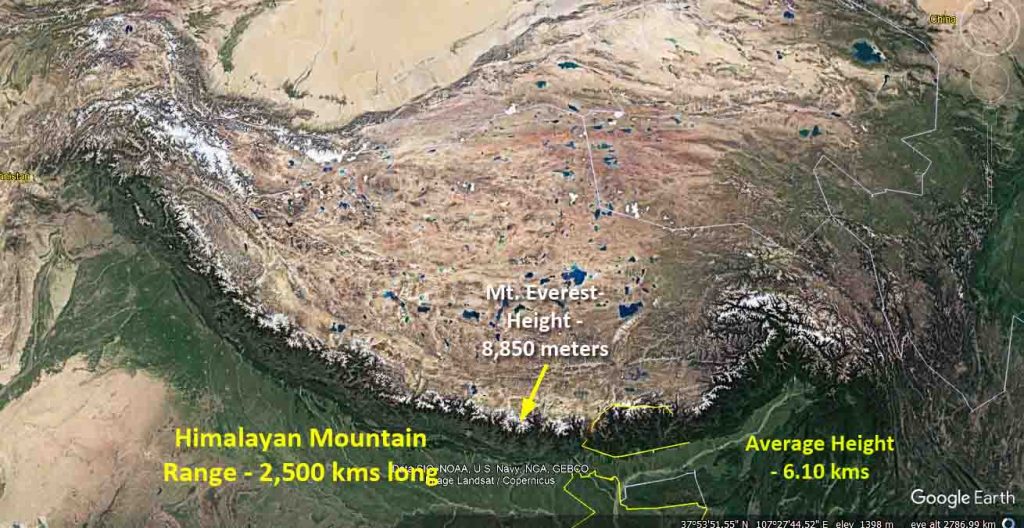52 Weeks in the Ark with Noah and Family (WEEK 7) – The Rainfall and Drainup* Ceased
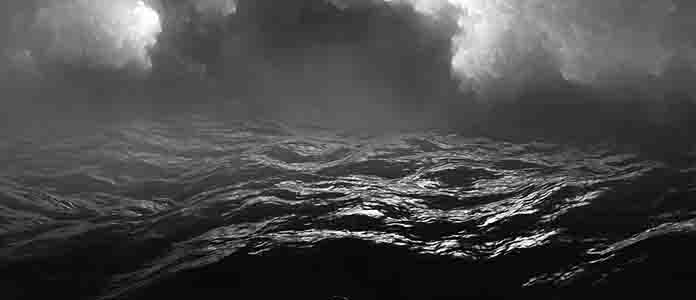
WEEK 7 (23rd to the 29th day of Shivan, the 3rd month of the Hebrew Religious Calendar)
We said that the Flood “came on the 7th day” after Noah and his family were told by Yah to enter on the 11th of Iyar. He had also expressly told these words:
For after seven more days I will cause it to rain on the earth forty days and forty nights, and I will destroy from the face of the earth all living things that I have made. (Gen. 7:4)
This fact has several significant possibilities.
- It seems Yah was counting precisely the days and nights; so, we concluded that the rain and underground water came on the night of the 17th of Iyar. “After 7 more days” could only mean that, for He then says “40 days and forty nights“. But the dilemma is that they could have entered the Ark on the 10th of Iyar, which means the 40 days of rain should start on the 17th day of Iyar and not the night of the 17th. This may seem trivial; but it is worth noting. We will probably make final conclusions after this entire Flood narrative, if we can.
- Since there were still no deep, wide oceans yet to contain the heavy rainfall and the drainup, the Flood must have come quite suddenly upon the land.
- The generally-flat topography of the world at that time must have greatly aggravated the rapid rising of waters everywhere, giving humans practically no escape room at the start.
- Since much water gushed out from underneath (aside from the rainfall), the Flood became an encompassing and engulfing agent of terror and death for all living things. It would have seemed like being in the Reed Sea itself when Pharaoh’s army was swept and battered by the crashing wall of waters on both sides of the open path that Yah had miraculously made as the way to freedom from Egyptian slavery for Moses and the Hebrews.
- As there was water crawling up from their feet and water falling rapidly and voluminously from above, death must have come either instantaneously for many or, at most, within hours on the day it first rained down and drained up. The justice of Yah had been fully served; His wrath had been completely satisfied. In a tragic way, Yah was “unmaking” what “I have (He had) made”.
- On the first day then of the Flood – the 17th of Iyar – the waters must have covered the whole face of the Earth. And on that same day, the Ark creaked, rolled from side-to-side, pitched from back-to-front and lifted upon the face of the waters, leaving all living things outside either floating alive or dead. After 7 weeks and 40 days and 40 nights of water coming upon the Earth, we can say quite certainly that the Flood would have had exceeded 40 times the height of the Ark: 40 x 30 cubits or 1,200 cubits, equivalent to about 2,000 feet or 650 meters. Perhaps, even way above that, as we shall prove later. And most certainly as well, it would have had also covered the low hills and mountains by that time. No more raining down, no more draining up, no more land to see anywhere on the planet. Water had immersed and conquered the Earth once more.
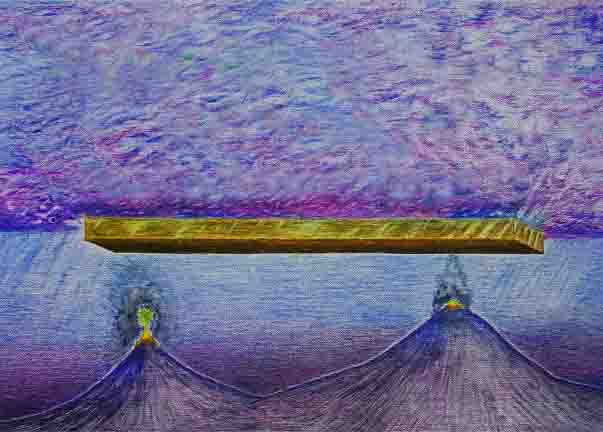
Rest and Refreshing of the Earth Begin
Thus, based on this scenario we visualize, the task of renewing the Earth and life upon it had begun. Renewal can only come after a process of complete change or destruction. There is “a time to break down, and a time to build up”. (Eccl. 3:3) The Earth and the Great Flood amply reinforce the truth and the wisdom of Solomon’s words, long before he had written them. His words now also serve as prophetic words for us for the present and future events that are unfolding and will unfold during these final days of the Earth.
Noah’s story — giving rest to the world, as his name suggests — will never grow older than the renewed Earth it gave birth to. Water, as we have seen, had given birth to all things, as it gave birth to the Earth which we have now received from Noah as our legacy, as well as the ultimate inheritance of all humans who have ever been born and will ever be born upon it. On this 7th week of our intrepid crew’s journey, the waters from above and below would be stopped on the 3rd day of the week or the 27th day of Shivan.
The Ark and the Coconut

For the Ark to start floating — and for any floating object — its weight must displace or take away a volume of water having an equal weight to the floating object’s weight. For example, a one-kilogram coconut that has about one liter of volume will float in sea water (that is, its density is approximately equal to salt water), almost submerged, but not sink, since it is buoyant. On a calm sea, you will barely see it break the surface; but on a slightly windy day, it will break the surface and then sink slightly as the waves move through it. By the way, that is how coconuts survive, migrate, grow and populate thousands of isolated islands in the Pacific. It is virtually a mini-Ark “tree of life” full of life-giving nutrients and valuable materials for tools and for building homes. And yes, it can also survive for months and maybe even a year or so, until it can germinate and bear fruit somewhere and even feed a whole family all year-round.
We use the coconut to illustrate how the Ark itself must have also been designed to behave and to serve its purpose. From our estimates, we find that the floodwaters must have reached almost to the top of the Ark, leaving only a few cubits or so. Remember that Yah had specifically told Noah to put a window “a cubit from above”. (Gen. 6:16) Talk about an Architect giving details to a carpenter – rather THE ARCHITECT and His Apprentice – and where exactly to place a window. A cubit is almost as long as the forearm of an adult person – from the elbow to the tip of the middle finger. Noah could have reached up with his arm and felt the top of the Ark and know if it was wet or dry, moldy or slimy. We can confidently say that the floodwaters never reached or breached that level of the window, even if the Ark had pitched wildly to and from during the stormy days and nights. Unless it was fully water-tight, which we assume was not. Nor was it necessary for Yah to close that window from outside, or Noah would not have been able to open it and release the dove later on.
The advantage of an Ark floating almost submerged under the Flood mimics the resilience of the coconut fruit or pod or nut or ark, whatever it is, although the latter seems quite appropriate now as it is. Wood will last longer underwater because it has less chance to rot due to oxidation or the action of oxygen, chemicals and microorganisms that feed on cellulose. We know wood has long been used as a sturdy shipbuilding material, especially lumber from hardwood tree varieties. Some are even almost indestructible in water and can survive for centuries without rotting at all. And since it did not rain for the 120 years the Ark was being made, it had dried and seasoned long enough to become almost as durable and strong as rock. Certainly, it had retained its flexibility to allow it to slightly bend with the forces of the floodwaters and its own weight.
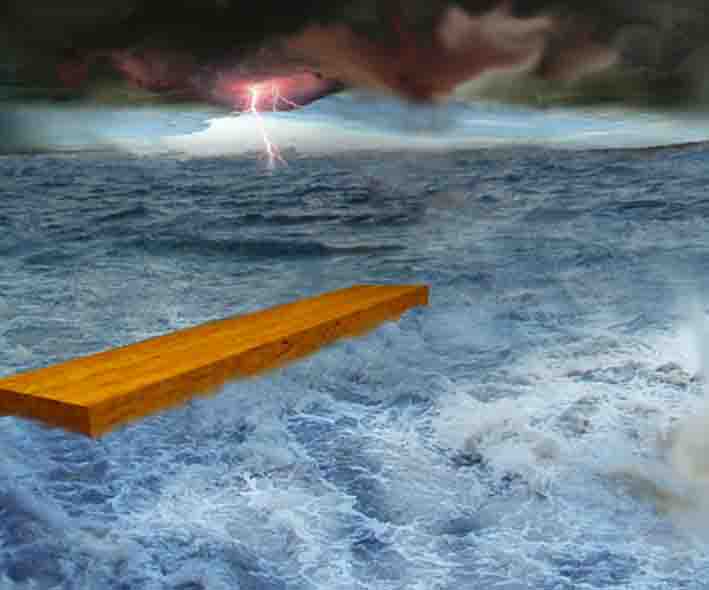
Floating Almost Submerged
Moreover, an almost-submerged Ark allowed it to float way below the hurricane winds that swept down from the skies and over the waters during the cataclysm. That way, it did not sway as much as would have if it were more exposed over the surface. And the smaller area exposed for waves to batter the Ark on its sides would have also kept it more stable, if not immovable. Below the surface line, the Ark remained safe and unperturbed by winds, waves and thunderstorms.
But now, even the sound of falling rain had disappeared. And, perhaps, the rumblings of underwater volcanoes had also ceased. The winds and the waves hushed down their angry voices as the worst punishment ever to be dealt upon humans and the Earth had passed. The family heard only the plaintive groans, growls and peeps of their zoo wards. They still had a long way to go before they could see the light and breathe the air outside. After 40 days, the Ark floated thousands of cubits above the surface of the Earth where humans had once dwelt. Now all those humans floated along with the rest of the Earth’s discarded parts. Judgment had been rendered. Noah and his family trembled at the thought of what was happening to the world they once knew as their home. Their new and temporary home was now the Ark, shared with the rest of the remaining breathing creatures on Earth.
How Deep was the Flood?
But what really happened during the 40 days it had rained down and drained up? What did Yah keep from the eyes and knowledge of Noah and his family? We had said earlier that in the Earth Expansion Model, the primeval world contained a supercontinent that previously incorporated and interconnected all the separate continents and islands today. That Pangaea was totally covered over by water reaching to 3,000 meters high. How did we come up with this figure?
If we were to construct a globe that contains a single continent with the same area as that of all the land masses of continents and islands we have today, the radius of the Earth would be reduced to about half (3,036.00 kms) of the present radius (6,367.44 kms) of the Earth. And using the estimated volume of existing water in the oceans, the whole amount of water would then submerge the older, smaller Earth by a 3-kilometer deep flood. That is what we end up having logically, scientifically, mathematically and historically. And if we were to remove half or a third of that water and hide it beneath the Earth, the height of the flood would be slightly reduced but would still submerge the globe substantially. But in so doing, we would be reverting back to that moment in the past before Yah said, “’Let the waters under the heavens be gathered together into one place, and let the dry land appear’”; and it was so. And Yah called the dry land Earth, and the gathering together of the waters He called Seas. And Yah saw that it was good.”. Back to the 3rd day when light and the water canopy had just been created.
Note in particular how Moses said that the waters were “gathered together into one place” and the dry land (not lands but also one land) appeared. Was there only one small, shallow ocean into which all the 4 rivers of Eden flowed? On a generally-flat globe, you could actually have a small body of water fed by a river system that forms a worldwide network (a water-web) not generally run by gravity or fed by rains as much as it is fed by a continuing cloud of mist that fills the rivers enough to run indefinitely. And the rivers need not have been so deep and wide either. And we will appreciate this assumption more when we see how much water would be added in order to flood Noah’s world.
The Earth ReCreated, ReBuilt and ReConfigured
Essentially, we are back to the first few moments Yah had given “visible and sensible light” to the Universe, even before humans existed. But in that parallel moment 40 days into the Flood, light had already been existing, although humans were in the darkness of the Ark’s womb. It was a confirmation of Yah’s decision to destroy the Earth and to create New Heavens and a New Earth.
The New Earth now has deep oceans having deep trenches and it also has high mountain ranges with tall peaks, all of which challenge the adventurous to climb, explore and conquer. Noah did not have adventure in his mind; nor did he intend to climb, explore or conquer any place or gain glory in this world. He heard the word of Yah and simply obeyed. Yes, as we have suggested, he floated 3 kilometers above the former surface of the Earth. And looking at the maps below, we will notice that given the geological features labeled, which had not been present before the Flood, Yah indeed introduced these new features for certain purposes he had and has for humans. We introduce these features without discussing how they could have come about and only wish to give an idea as to where the great volume of waters of Flood eventually would go in our future discussions. Initially, we will state that in the generally-flat and smaller globe, these trenches and mountain ranges had not been formed but were, in fact, being formed during the cataclysmic period of the Flood. Many may reject this idea of a year-long reconfiguration of the Earth in such magnitude; however, we have laid down the valid premises that show we have been on the right track all along. However, our story has just begun.
Notice, for instance, that the deepest trench which is located in the Pacific Ocean, the Marianas Trench, runs for about 2,550 kilometers while the Himalayan Mountain Range runs for about the same distance of 2,500 kilometers. However, Marianas Trench is much deeper than the Himalayas’ height, dipping to as low as 11 kilometers at the Challenger Deep, whereas Mt. Everest rises up to only 8,850 meters. We have heard it being said that Mt. Everest could be inserted upsidedown into Challenger Deep with room to spare. However, we say, the Himalayan Range can be entirely swallowed up by the Marianas Trench. That alone would tell us that no matter how tumultuously the Earth’s crust must have convulsed during the Flood’s rebuilding of the globe, and with all that solidified magma, mud and soil scrambled upon the face of the Earth, the floodwaters would have still covered the new, bigger and reconfigured Earth with enough water. By that, we mean that if we were to flatten all the mountains of the world and brought up all the trenches to form a totally flat Earth surface, there would be enough water to flood it by thousands of meters.
The average depth of the oceans is 3.70 kilometers, as Google states. That watery part of the Earth covers roughly 70% of its total surface area. In a smaller Earth, a less rugged topography (assuming no deep ocean basins and high mountains) would allow a global flood to cover it to an almost even depth worldwide. If we leveled all the mountains and filled up the oceans to attain a flat surface, the existing water would, in fact, cover the present globe to a depth of 2,286 meters. A smaller Earth, on the other hand, would be under 3,658 meters of water.2 Hence, we can imagine the Great Flood to have reached at least 3 kilometers deep before the Earth gradually expanded and attained its present radius. This comparison proves we would still have a deep global flood if not for the configurations that Yah made to allow the floodwaters to “subside” or, more precisely, to be distributed while building mountains and continents to “divide the waters” as He had done in the beginning. Rebuilding for Yah is almost like Recreating for us. Hence, the New Heavens and the New Earth granted to Noah and his family, which are now our inheritance.
Why We Still Have the Same Amount of Water as Before
We will provide more illustrations later, as well as topological proofs that in a flooded Earth, no matter how you may rearrange the solid materials underneath, you will never reach the point when you will be able to force back water into the Earth (by what force or mechanism?) or discard some of it into space (again, how?). All the water we have today on the Earth’s surface has approximately been the same amount of water that existed in the Great Flood. Perhaps, more has been added since then. From where? Where else but from the springs of the deep oceans and the inner Earth. As we said, the Earth continues to expand. Volcanoes continue to erupt. The “springs of the sea” continue to flow from underneath. (Job 38:16) The continental ridges continue to extrude magma, and, perhaps, also ample amounts of water released through hydrothermal vents.
By the way, why should only volcanoes and the deep-sea springs contain fresh water while hydrothermal vents are deemed by scientists to be fed only by the seepage of saltwater into heated rock materials beneath? How can we be fully sure that all that water is seawater and not fresh water as well coming from beneath? These vents exhibit high-pressure and high-temperatures conditions and are supposedly tightly-sealed. How then can seawater enter under such conditions? The fact that the salinity around these vents can dip to as low as 0.1 wt% NaCl (in contrast to seawater’s 3.2 wt% NaCl) makes us wonder why. They label this phenomenon as “depletion“, to mean the lack of minerals. But why not “dilution”, that is, the addition of fresh water? How can saltwater be any “less saltier” in highly-mineralized zones such as hydrothermal vents at the bottom of the ocean? Something tell us these scientists work within the paradigm of the Plate Tectonics Theory, not knowing any other valid paradigms. Wrong assumptions can blind us from the truth, as many have been for so long.
We end here by saying that water formed all things in the beginning and continues to perform a vital role in the processes of Earth’s life and the life on it. Our Planet Earth is a living and thriving part of Creation that had undergone a rebuilding in the time of Noah. Whatever theory you may choose to believe and defend, do not take away the primordial and incontrovertible role that the Creator had played and continues to play in preparing it for His intended purposes for humans, whether in the distant past, in the present, or in the final days of His Creation.
Notes:
*1We coin the word “drainup” to refer to the waters that came up and out of land springs, deep-sea rivers, deep-ocean vents and volcanoes. This will differentiate from the “rainfall” coming from the Water Canopy, as well as from the terms “drain out” and “drain down” (to remove water by either bringing it out, as you would in draining out a river to show its dry bed , or allowing water to go down into a drain, as in allowing the water in a pool to drain down for cleaning the pool). Drainup has a more dynamic connotation since it assumes there is pressure or some motive force causing water to rise and even erupt or gush violently into the air and upon the land. We will also use the terms “spring up/spring out“, “gush up/out“, and “flow up/flow out” to mean the same thing.
2The Almanac for Farmers and City Folk.
